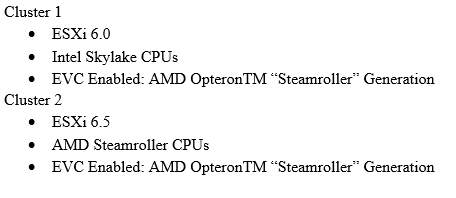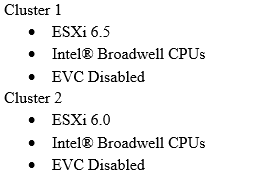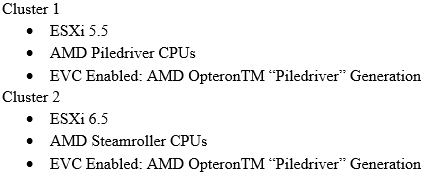Download VMware Certified Advanced Professional 6.5 – Data Center Virtualization Design.3V0-624.ActualTests.2018-11-08.32q.vcex
| Vendor: | VMware |
| Exam Code: | 3V0-624 |
| Exam Name: | VMware Certified Advanced Professional 6.5 – Data Center Virtualization Design |
| Date: | Nov 08, 2018 |
| File Size: | 493 KB |
How to open VCEX files?
Files with VCEX extension can be opened by ProfExam Simulator.
Discount: 20%
Demo Questions
Question 1
A database administrator is operating a virtual machine (VM) configured with 16 vCPU and 64GB of RAM. A recent performance audit has indicated that this virtual
machine is oversized and is using less than 60% of its configured CPU and memory capacity.
- The ESXi host that contains this VM has 2 physical processors with 10 cores per processor, and 128GB of RAM.
- This physical host’s architecture is split into two equal NUMA nodes.
Which vCPU and RAM configuration for the VM allows for the most resources, but also provides the performance benefit of local NUMA access?
- 16 vCPU and 32GB RAM
- 4 vCPU and 16GB RAM
- 10 vCPU and 64GB RAM
- 12 vCPU and 64GB RAM
Correct answer: B
Question 2
When implementing update policies for the vSphere environment, which would be the VMware-recommended way to update the vCenter Server Appliance (VCSA) when an underlying operating system (OS) patch is released?
- Introduce a policy that requires a system administrator to check if a new appliance update (which might include an OS update) is available from the downloads section of MyVMware portal, and follow the VCSA documentation to apply the update.
- Do nothing-the VCSA applies all OS updates automatically without any human interaction.
- Introduce a policy that requires a system administrator to go online and check with the OS vendor to see if a new version is available. If it is, download it manually, log in to the VCSA with the root credentials, and proceed with the OS update.
- Configure VMware Update Manager to download the OS update and apply it on a scheduled basis.
Correct answer: D
Question 3
A solution architect has finished conducting interviews and gathering requirements for a company, and has determined that the logical requirements are:
- Two data centers for high availability
- Synchronous replication to meet the zero minute RPO
- Separating management workloads from application workloads
- Dedicated 10Gb uplink for each low latency server
- Single management point for the entire environment
Which two actions would meet the design requirements? (Choose two.)
- Configure 1 Port Group with a dedicated 10Gb Uplink for low latency servers.
- Deploy two clusters, one for management workloads and one for application workloads.
- Build 2 Port Groups, one for management servers and one for application servers.
- Install two vCenter Servers in Enhanced Link Mode.
Correct answer: AB
Question 4
A solution architect has made the following design decisions:
- Leverage existing hardware that is certified on earlier versions of vSphere but is NOT on HCL for ESXi 6.5.
- Upgrade vCenter Server to version 6.5.
- Configure separate clusters based on ESXi versions 5.5, 6.0, and 6.5 for newly purchased, certified hardware.
- The underlying CPU family is compatible.
- There is enough resources available to vMotion virtual machines (VMs).
Given this scenario, what is the correct statement about the ability to vMotion virtual machines between versions of ESXi?
- VMs created in vSphere 5.x must be upgraded first to newer virtual hardware and then be vMotioned to vSphere 6.x.
- VMs created in vSphere 6.x environment with default settings can be moved to ESXi 5.x.
- VMs can be vMotioned to the same or newer version of ESXi.
- VMs that are created after the vCenter Server 6.5 upgrade can be vMotioned between any supported versions of ESXi.
Correct answer: A
Question 5
The system administrator team is planning to upgrade its vCenter Server 5.5 environments to version 6.5.
- Each vCenter 5.5 is pointing to a Single Sign On (SSO) server that has a dedicated virtual machine
- The SSO servers are currently in independent SSO domains.
- During the upgrade process, the administrators would like to combine their two SSO domains into a single one.
View the exhibit.

Referring to the exhibit, which upgrade scenario would accomplish this?
- 1. Upgrade the Denver SSP server to a 6.5 PSC.2. Upgrade the Denver vCenter Server 5.5 to version 6.5.3. Use the migration utility to upgrade the New York vCenter Server to 6.5.4. Choose to join it to the Denver PSC.
- 1. Upgrade the Denver SSP server to a 6.5 PSC.2. Use the migration utility to upgrade the New York SSO server.3. Choose to join the existing SSO domain during the second upgrade.4. Upgrade both of the vCenter Servers to 6.5.
- 1. Upgrade both of the SSO Servers to 6.5 PSCs.2. Upgrade both of the vCenter Servers to 6.5.3. Install a new 6.5 PSC in the same SSO domain as the Denver 6.5 PSC.4. Repoint the New York vCenter Server to the newly-installed PSC.
- 1. Install a New York SSO 5.5 server in the same SSO domain as the Denver SSO server.2. Repoint the New York vCenter Server to the newly-installed SSO server.3. Upgrade both of the SSO Servers to 6.5 PSCs.4. Upgrade both of the vCenter Servers to 6.5.
Correct answer: B
Question 6
A company is in the process of deploying a modern video-streaming application.
- The application is able to scale (expand and collapse) its streaming nodes in the form of CentOS 7.x 64bit virtual machines, based on demand.
- This IO-Intensive application has a high CPU demand and generates a significant number of disk operations (IOPS).
- To host the application, the company decided to implement a brand-new VMware cluster with vSphere 6.x.
- The company would like a significant reduction in CPU utilization as well as possible increase in throughput.
Which virtual disk adapter should be recommended for the company’s physical design?
- LSI Logical Parallel
- VMware Paravirtual
- BusLogic Parallel
- LSI Logic SAS
Correct answer: B
Explanation:
Reference http://virtuallyhyper.com/2012/09/vcap5-dcd-objective-3-5-determine-virtual-machine-configuration-for-a-vsphere-5-physical-design/ Reference http://virtuallyhyper.com/2012/09/vcap5-dcd-objective-3-5-determine-virtual-machine-configuration-for-a-vsphere-5-physical-design/
Question 7
A solution architect has been tasked with designing a new environment for a company’s growing needs, and has obtained this information:
- Uptime is critical during regular business hours when 95% of the transactions occur. Application uptime must be 99.9% during those hours.
- In a true disaster, the business can withstand a day of data loss and half a day of downtime.
- The company is one year into a 5-year contact with the co-lo data center.
- The building that is currently occupied no longer has any floor space available, but the company has 3 empty racks of space. The co-lo can provide up to 11KVA of power per rack.
- There are current contains with Dell to provide servers and with Cisco to provide the network components
- The network team has standardized on an end-to-end 10Gb network.
Based on this information, what are two requirements for the new design? (Choose two.)
- RTO of 24 hours.
- RTO of 12 hours.
- The application must be available 99,9% during business hours.
- 11 KVA of power is available per rack.
Correct answer: AC
Question 8
A customer has storage arrays from two different storage vendors at two different sites. The customer wants to restore operations at the secondary site in the event of a disaster.
Which VMware technology must be used to meet this requirement?
- vSphere replication
- vSphere Data Protection
- array-based replication
- vSphere Fault Tolerance
Correct answer: A
Question 9
The ability to live-migrate all virtual machines between two clusters is a requirement in the customer’s design. Which two clusters and EVC configurations will accomplish this? (Choose two.)
Correct answer: AD
Question 10
Which two types of workloads are efficiently consolidated when virtualize? (Choose two.)
- Workloads that do NOT require user input and are constantly processing large amounts of batched data.
- Workloads that will consume all available assigned resources.
- Workloads that are NOT CPU bound; most of their time is spent waiting for external events such as user interaction.
- Workloads that do NOT require access to specific physical resources such as a hardware dongle or graphics card.
Correct answer: AC
HOW TO OPEN VCE FILES
Use VCE Exam Simulator to open VCE files

HOW TO OPEN VCEX AND EXAM FILES
Use ProfExam Simulator to open VCEX and EXAM files


ProfExam at a 20% markdown
You have the opportunity to purchase ProfExam at a 20% reduced price
Get Now!







